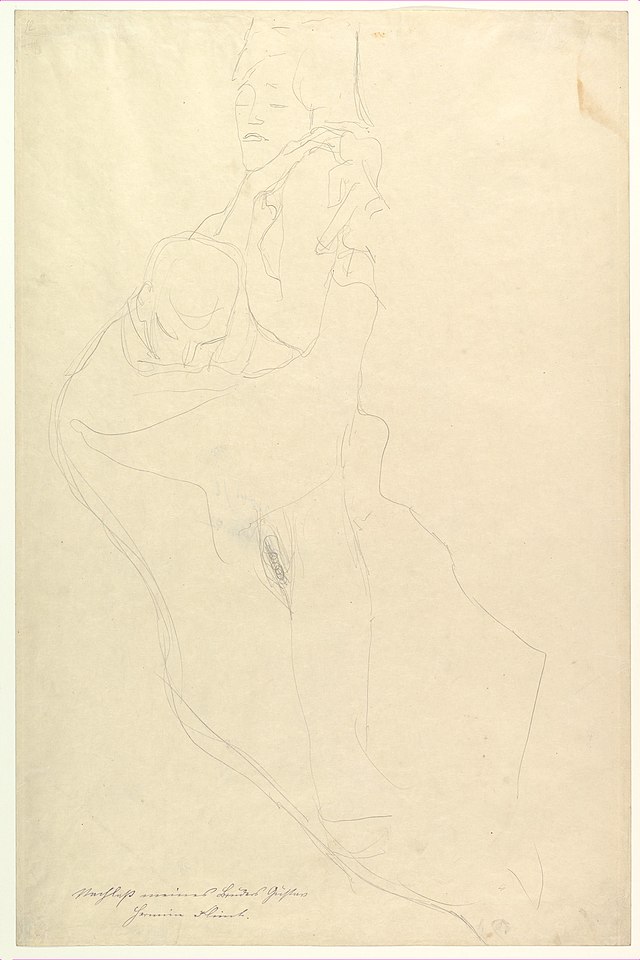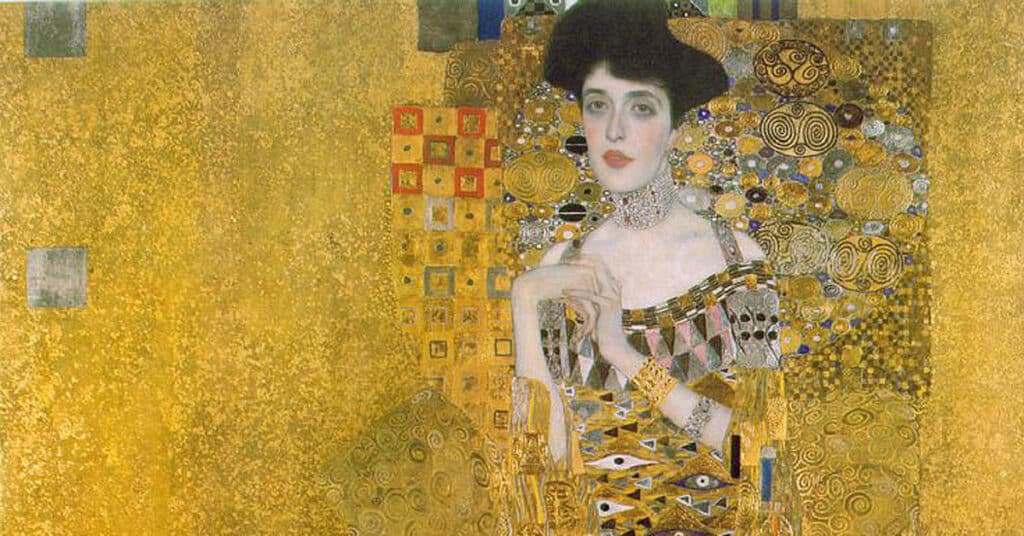Gustav Klimt continues to be remembered and celebrated for his art, as well as his role as a
co-founder of the Vienna Secession. Although Klimt has gained significant notoriety and
significance as an artist and figure in art history during the contemporary era, his work was
often dismissed as too erotic, sensual, and sexual at the time of its creation.
Klimt continues to be recognized for his use of the female body, and his boundary-breaking
– some would even say taboo – use of the naked or nude woman in his artwork. In fact, a
selection of Klimt’s graphite drawings are so explicit that they remain challenging to exhibit
today, which can make locating published examples of his erotic oeuvre a challenge.
The openness with which he engaged with themes that were considered abhorrent and
indecent at the time resulted in heavy criticism from the contemporary press. Rife rumors
about supposed love affairs with the subjects of his work also plagued Klimt: many of these
rumors remain unsubstantiated, but it is highly likely that his studio played host to less-
than-professional liaisons with nude female models that, unfortunately, was consistent with
the behavior of artists towards their models. This has prompted calls – and sometimes even
protests – for museums and galleries to clearly mention when male artists may have
mistreated their female models.
Klimt was a figure of great uproar and outrage, but his work unequivocally influenced artists
including Egon Schiele, whose own work expanded upon the use of the naked body first
embraced by Klimt.
The Lovers
The Lovers, a piece created in 1913, is one of many graphite drawings by Klimt that
embraced the sexual and erotic. The Lovers shows a heterosexual couple (man and woman)
who engaged in lovemaking. The woman lays on her back, and, whilst her face, which is
directed towards us, demonstrates some degree of detail, the rest of her body is merely
suggested through Klimt’s spare use of delicate graphite lines. The man’s body has even less
detail: it hovers above the woman, and his head and facial features are faintly detailed.
Most central to The Lovers is the woman’s genitals. Compared to any other feature, these
are given the most detail by Klimt, and are also positioned centrally to The Lovers. The
drawing is explicitly sexual and taboo, and embraces the erotic, sensual, lustful nature of sex
and love, all of which were themes that Klimt leaned into as his career advanced, even and
in spite of contemporary criticism of his drawings as pornographic and repellent.
Klimt created over four thousand drawings (that are currently known), all of which were
dedicated to the female form. Many were undoubtedly sketched before commencing more
intensive work on a painting, as Klimt captured one of the many nude models that he had
pose for him.
Images like The Lovers include Standing Nude (1906-07), Two Studies for a Crouching
Woman (1914-15), Nude Figure (1913-14), Reclining Nude with Drapery (1913), and
Reclining Nude with Leg Raised (1912 – 1913), although there are many others. Nude Figure,
Reclining Nude with Leg Raised and Reclining Nude with Drapery in particular, have distinct
kinship with The Lovers, but are arguably even more taboo, as both show a reclining woman
touching her own genitals. In total, there are around fifty drawings made by Klimt that show
women in the act of self-pleasure. The explicit, daring nature of these drawings is made
more apparent with recognition of contemporary laws around masturbation, which was
punishable by invasive, torturous surgical treatments.

Klimt’s Erotic Work – An Overview
The Lovers is dated 1913, meaning that Klimt created the piece after having abandoned his
membership to Vienna’s Association of Austria Artists, or Kunstlerhaus. Along with a
number of other artists and designers, Klimt renounced Vienna’s influential society of artists
in protest against what they perceived as extremely conservative values and practices.
Klimt already had cause to feel ostracized and criticized by a mainstream media who
deemed his work too explicit. In 1894, Klimt had been commissioned by the University of
Vienna to produce three ceiling paintings for the University’s Great Hall. Philosophy,
Medicine and Jurisprudence were criticized upon their reveal, however, for what was
perceived as their embrace of pornographic eroticism.
Philosophy depicted naked figures of all ages, but it was Medicine that arguably created the
most public outcry. Hygeia, the mythological daughter of the god of medicine, is shown
surrounded by nude figures, the most controversial of which is a floating nude female to the
upper left of the piece. What was perceived as the flaunting, thrusting pelvis of this figure
resulted in a number of politicians speaking out against the piece, which was critiqued for
what was perceived as its celebration of pornography.
The uproar caused by these three public commissions led Klimt to swear off public
commissions going forward, and may have further inspired him to lean into his celebration
of taboo topics of sexuality, eroticism, and pleasure. In 1899, around five years after the
controversy over the pieces created for the University of Vienna, Klimt revealed Nudas
Veritas, a near life-sized depiction of a young naked woman. Atop the piece is a quotation
by Friedrich von Schiller, but it was the female figure who drew the most criticism,
particularly for its display of pubic hair around the genital area. Traditionally, female nudes
were depicted hairless, so this detail heralded a marked departure from convention by
Klimt. It was a practice that he carried forward into his erotic graphite drawings – in The
Lovers, for example, the woman’s genitals are not only central to the piece, but are also
drawn with pubic hair detail.
From December 1913 to January 1914, Klimt exhibited the largest number of his drawings
yet at the ‘International Schwarz-Weiß-Ausstellung’ (International Black and White
Exhibition). Many of these were his more erotic pieces, which resulted in heavy criticism
from critics. Consequently, Klimt was loathe to display his drawings publicly, so frustrated
was he at their tendency to produce uproar.

Klimt’s Own Lovers
Klimt sired sixteen illegitimate children during his lifetime. Alongside the criticism of his
work, rumors circulated about elicit relationships with his female models, although these
remain largely unsubstantiated. Given the long history of use and abuse of young women by
male artists, the topic remains controversial, and Klimt is certainly an ambiguous figure
within this discourse.
Klimt certainly had an ongoing relationship with Emilie Flöge, and it is often suggested that
his most famous artwork The Kiss is autobiographical, depicting both Klimt and Flöge. It has
been noted, however, that they never consummated their relationship sexually, and that it
was one of romantic and spiritual fulfilment. Flöge was an artist in her own right, and was as
committed as Klimt to abandoning the conservatism of Vienna.
Whether or not Klimt also had a relationship with Adele Bloch-Bauer remains a subject of
conversation in the artworld. Klimt’s Portrait of Adele Bloch-Bauer I remains a celebrated
artwork with a storied history, and Adele was the only woman that Klimt painted more than
once. She has therefore been positioned by art historians as Klimt’s lover, although there is
no tangible evidence to prove this liaison definitely took place.
Certainly, The Lovers does not depict Klimt himself in a sexual encounter with any of the
women with whom he may have had trysts or affairs, but it remains a significant piece of
erotic artwork, and emblematic of wider themes in Klimt’s oeuvre.

